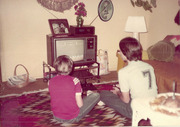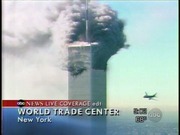tv Book TV CSPAN January 1, 2010 6:35pm-7:00pm EST
6:35 pm
you're going toe to toe with these madrassas. and i think you're an american hero for doing. that thank you been throughout on your own. you've been kidnapped at at least, once. is it still only once? >> one time. >> one time. so you really are an american hero and you've been throughout doing it on your own and it takes unique character and figure to do what you do and i know we only have a few minutes left. i'd like to briefly talk about special people and that is your wife and your children because i cannot imagine your wife tara what she puts up with. that you're gone for so long and how she deals with. i worry about you as my friend when you travel and how does she cope with this? >> guest: well, it's very difficult. what's also painful is i get a fair amount of criticism from people who say you're a poor husband or bad father because you got married and you have this responsibility and now you're off traipsing
6:36 pm
around the world doing your own thing and my daughter mira who has a black belt in tae-kwon do. she takes great pride in being part of the family and she says there's hundreds of thousands of kids in the u.s. whose parents are serving in the military or they're in humanitarian work and really it is -- or kids who have their parents on cop toll hill but it is kids who make the greatest sacrifice of all. it's not easy. we've had some struggles but we also make at it point to celebrate our time together. every tuesday night when i'm home we have a date night. no matter what we're going to go out and have a date. saturday is kids' day and again no matter what is happening the kids know their daddy is there for them on saturdays. and i also find i think it is like you for a long time
6:37 pm
it was difficult fur you -- for you coming to capitol hill ask you had -- and you had kids and trying to act as mother and you know, a politician and also bread winner and everything. my wife is a saint. but i also i think it's so important that the other half meaning women i think that they're empowered and they're -- we also have respect for women, mothers and we also give them the opportunities and especially in countries around the world where women are denied those opportunities and the more i do this, i'm convinced that girls education and helping out women with legal advocacy and with rights. it should be one of our top priorities. >> you're right. >> even as a guy.
6:38 pm
>> appreciate that. we've only got a couple minutes left. what are you hoping people will take away from the new book different than they did three cups of tea? what is the one in the last few minutes that we have, what are you really hoping to get out there to the american people? or to the world. actually the world audience. the worldwide aid yens? >> my -- audience? >> my hope is that first of all that every single child on this planet could have the right to go to school. there's 120,000. 120 million children who can't go to school and also in the states i hope that we can really commit ourselves to a quality education for all over children. i also think that when i'm trying to say with that -- with this book is i think there is hope for peace and i think the real reason. the real reason i do this is because i have two children and you have a couple of kids and i think we owe it to our children to leave
6:39 pm
them a legacy of peace and it is not going to be easy. but do i think we can persevere and there can be peace for all the people. on this planet. >> well, and with that perfect way to close i know. look for nobel peace prize for you and i still believe it is in your future and i know that's a hard thing for you to hear but a lot of people are very grate sqfl appreciative of what you do and the sacrifices you and your family make. so i look forward to years of more work with you in any capacity that i possibly can and wish you the very best of your new book. and with your endeavors. >> well, thanks marion. it's been such an honor to spend some time on c-span with you. and thanks for all of your help and from the day i first met you in your little baseball cap also it's been wonderful to have you introduce me to people here in washington, d.c. and i
6:40 pm
think also on behalf of all the children in pakistan and afghanistan, i'd like to thank the american people for supporting them and for really believing that we can help them all have the chance to go to school and have peace. >> very well. thank you so much. >> thanks. >> well, the united states holocaust museum has undertake an research project and it is in book form. this is volume one of the research project. jeff is the manager what is the this project? >> all the different camps and ghettos the germans during nazi period and all of their allies ran. >> and how many have you found? >> we we have found well, within the volumes we're going to have about 20,000. >> 20,000 camps. were you surprised at the number? >> yes we were.
6:41 pm
>> why? >> when i came on board in 2000. the people who had created the project. historians themselves had estimated there were about 5 thousand tow to 7,000 sites we would be looking at. this turned out to be one of those instances in which a lot of different people around the world had been doing research in their own little corners and nobody had ever put the numbers together. so when we started looking through secondary sources and contacting historians and finding out about the different categories of camps the numbers started to build and within three to four years we were up to 20,000. >> well what are the different categories? >> well, the big ones are the concentration camps auschwitz dah call. the names that people know. plus the m sub camps around them. and that's what this first volume deals with in large part. each of those places. stock call for example had 124 sub camps associated with it. places where the prisoners stayed with worked. -- stayed and worked. the other big categories would be prisoner of war
6:42 pm
camps and forced labor camps and get toes. >> what is an example of a forced labor camp? >> in addition to the concentration camps which were more or less really punitive in nature the germans also brought millions of people into nazi germany simply to support the economy. they weren't being punished for anything necessarily. usually not jewish. the jews were put into a separate system. but the forced labor camps were strictly to support this war economy to allow germany to manufacture the arms it needed to fight the war. >> and you also talked about p.o.w. camps. >> yes. >> and those are chronicled in these encyclopedia also. >> they will be yes. >> how many of those have you found so far? >> we're looking at about 1,000 main p.o.w. camps. the p.o.w. camps also had sub camps and the numbers there are astounding and
6:43 pm
well beyond our ability to cover them in the encyclopedia. >> you mentioned dachau. how is it developed that dachau would have 124 sub cams? how is that organized? >> well, this was again a function mostly of the war economy. some of the concentration cams such as mount houseen for example were originally created in part to serve economic ends. mount housen had a quarry nearby for mining stone, acquiring stone that would be used in nazi grand architecture that hitler was planning for berlin for example but over time especially as you got into 43 and even more so in 44 as the war economy needed more and more labor the ss that ran these cams started to sort of farm out their prisoners. rent them out literally to military-industrial concerns and they decided pretty
6:44 pm
quickly the most efficient way to do that is to have cams at the work sites. so these systems of sub camps developed from there. >> about how many people do you estimate were processed through these 20,000 camps? >> we don't really have an overall estimate. there were. at the height of the concentration camp system there were about 750,000 people. in that. that would have been at the beginning of 45 before we started to retreat and evacuate a lot of them that's not the total number that went through there. that would probably total i'm guessing here to some extent but at least a couple million. probably more than that. there were something like 10 million forced laborers in germany if i recall correctly. p.o.w.s. probably about a similar number. so you're looking at tens of millions of people. >> how did this system develop? how did the germans develop this system? was it done by one
6:45 pm
bureaucracy or was it just sporadic? >> no. i use the word system as well for lack of anything better. but strktly speaking you couldn't call it a system. each set of cams -- camps developed more or less on its own. this first volume of the encyclopedia covers the early camps about 100 of those that developed in the first few months after the nazis came to power and then from those the concentration camps evolved. and so this was the sofrt punitive side. p.o.w. camps were a normal part of fighting a war. forced labor camps gol government into play and they started running out of workers and specialized small erakat girs of camps for their own special purposes. >> but nobody in charge say in berlin who was in charge of setting all of these up? >> no, no. all won by different bureaucracies. as a matter of fact, i think it was in a sense part of the nazi system for each
6:46 pm
bureaucracy to want to have its own camps. this was i think. we don't have firm evidence of this. but i think this was something for a lot of nazi bureaucrats indicated that they had power. i have my own body of prisoners here that i control. i have my own purpose for which i have camps. >> what were the first camps that the nazis developed? >> these were the so-called what history cans -- historians call the early camps they were developed on an ad hoc basis by local authorities. it was brownshirts in some cases the ss or the local police to handle political prisoners. communists and socialists especially at the beginning. people that the nazis considered to be arch-enemys and that they were determined to eliminate. they didn't eliminate most of them physically but put them into these camps and tortured them and put them to work and more or made sure they were not going to
6:47 pm
be active members of the political scene anymore. >> where was the 1942 final solution meeting fit into all of this? did that develop more camps? >> i don't believe that the conference as it is called developed more camps directly. this was really an implementation meeting. the decision for the final solution had been made. i think most historians agree on that and there were already, there was already one camp in operation there were others that were coming on line. i'm talking about extermination center now that were designed solely for the purpose of killing people. the conference was the -- a person in charge of the main office. this was his opportunity to get all of these other bureaucrats together from different ministries within the government and say i'm in charge of this effort to wipe out the yous and you all have to follow in line and so this meeting is to sort out any little bureaucratic obstacles to
6:48 pm
that. >> what have you discovered about life in these camps and at the various levels? >> it varied. it varied more than most people realize. if you were an english or an american prisoner of war you were at to some extent the top of the hierarchy. the nazis did not consider you to be racially dangerous. you were as close to "air yans" as anyone was going to get. and also the nazis feared to some extent the treatment to their own p.o.w.s might be negative if they miss treated americans and british. so you put those things together and those prisoners fared relatively well. i want to emphasize that word relatively. some people were abused horribly. some people were separated and put into concentration camps. most of them could receive red cross parcels and
6:49 pm
through most of the war and they did all right. at the other end of the spectrum. even just within the p.o.w. community. if you look at soviet p.o.w.s the germans captured about three and a third soviet p.o.w. in the first year of their war with the soviet union. >> three and a third million. >> yet about two and a third million of them were dead by the spring of 1942. several hundred thousand of shot outright because they were communists or jews. more of them killed through forced labor. starvation e exposure. disease simply being neglected. so that was the other end of the p.o.w. spectrum. you go in a sense farther than that with the yous and the exeter -- jews and the e termination centers who were brought there and killed. >> how many e termination centers have you counted? >> we count six. just six? >> yes, because we have this narrow definition of e termination center its primary purpose was to kill.
6:50 pm
we avoid death camp because that get ace plyed to a lot of places where a lot of people died where conditions were horrible but the purpose was not primarily to kill people. so we count auschwitz, ma donic. tra when ka. soviet bore. -- not dachau. dachau was a concentration camp. >> really? and who was in dachau? >> political prisoners at first. there this -- this was first of the ss concentration cams it was create aid long with the other camps in the very beginning of 1933. and then when the s,s took over the other cams in 34 and 35 they closed most down and kept dachau open and opened a few others and dachau became one of their model cams. it helped political prisoners at first and then increasingly all of the different groups that the germans brought into their concentration camp system.
6:51 pm
homosexuals. political prisoners of various stripes from resistance fighters. anyone who tried to buck the system really could become a concentration camp prisoner. >> you also talk about the different ghettos. how do you define a ghetto and how many of those have you discovered? >> we define a ghetto for the purpose of the encyclopedia we've had to use a rather practical approach to it. a ghetto is a place where jews were concentrated. usually in an existing jewish neighborhood or in some part of the city or town prior to their murder. they were again created on sort of an ad hoc basis. as the germans advanced east wards and they started in 1940 in poland but especially as they advanced in the soviet union in 1941 they needed to do something with all of these jews. they weren't sure quite what
6:52 pm
they were going to do with them in the end yet. but in the meantime they needed to concentrate them and this served really three purposes. to concentrate them. it kept them under con trom -- control. they were not given a whole lot in terms of food or medical care. so a lot were killed off in that way. several i think 1.2 million or so. died within the ghettos. and it also well, keeping them under control and killing them off was the main thing. but it also allowed them to work for the german war economy to some extent. >> how many have you discovered? >> about 1200. >> about 1200 get toes. how did you do this research snch. >> well, we have not done all that much of it. we depend largely on outside contributors. now, saying that there was about 30% of this first volume we had to write ourself. mostly from secondary sources. from published sources and that proportion will
6:53 pm
probably increase as we go along because most of these categories have not been thoroughly researched. we have right now three or four people who are work for us who are writing entries and doing research for entries. it's not a team to be doing something of this scale but over time we were able to manage it. but for the most part we depend on local experts. volume one for instance with auschwitz and another concentration camp we had people in the memorial sites in the museums there who volunteered to write all of the sub camp entries for those places. in other instances we might come across swufrn who -- someone who knew about one camp and he or she had made that his or her particular study. they knew all about and it they could write that one entry for us. >> and how long would an entry be? >> for a main concentration camp we're looking at about
6:54 pm
2500 words. not a lot. that's about 10 double spaced pages. and obviously covering a place like dachau and auschwitz that that space is ludicrous. but we know sh not the main source people will go to for cams like that. with the sub camps and the entries there were about half of that length. about 1250 words. when we could get enough information for them. the sub camps are the places that are less well known. these are the places that are really important for us to document because information on them is just not available anywhere else. and this serves well, for one thing to document the suffering of the people who were there. and the sur viers with whom i've spoken have been very impressed we've been able to do this for them in a sense. it also 1 a big slap in the face to "the deniers" as well. it is a part of the job i particularly enjoy. >> jeff is the editor of these first of this first
6:55 pm
volume part one and two. how many volumes will be coming out? >> 7. >> 7 total? >> yes. >> and this specific volume is about? >> this specific volume that's out now is about -- the subject matter? >> yes. >> oh, this covers the early concentration cams that i talked about and the main concentration camp system. the big names and their sub camps. >> what will the future volumes be? >> they're organized by type of cam. we thought that would give people an opportunity to see what the system was like in as much as there was one. volume two will cover german one ghettos volume three cams run by the german military. volume four. cams run by germany's allies and satellite states. five will deal with another set of cams under another branch of the ss. six will deal with forced labor camps not under the ss
6:56 pm
run by pry firms and other organization and 7 will be a catchall thing that didn't fit in anywhere else. >> were the folks who did a lot of your research, did they things, anything in the german archives? >> oh, yes. yeah. >> else sp -- especially volume one most of the information comes out of german archives. >> is it well documented these camps? >> it depends on the camp but generally yes. >> host: and what kind of documents would you find? >> guest: we'd have documents setting up the cams. documents testifying to who was sen there. how many people what kinds of prisoners. what kinds of work they did. things of that nature and then we have prisoner testimony about what life was like in the camps. what kinds of treatment they received. people who were killed that sort of thing. >> what's your goal? with these encyclopedia. >> it is really twofold. one is to provide basic information about as many of these places as we possibly
6:57 pm
can. and so we have a series of research questions we ask each of our contributors to try to answer. what kinds of prisoners were there. how many, who ran the place. who guarded it. what was its purpose. what kind of work was done and for whom, for what companies? how did people live. how did people die? were there trials of camp personnel after the war. all that sort of thing. so that's one goal. the other goal is to provide a foundation for further research and so each of these entries has a source section. that discusses where the author found the information that is in here. it servings as a starting point for anyone who wants to try to continue on. and as you can see we also have foot nits to particular important points within each entry. >> how long have we been work on this0 project? >> 10 years in january. >> and what's the -- how much longer will you go? >> we're hope toeg get the whole thing done by 2018.
6:58 pm
we've been working on various volumes in tandem. so we're about two years away from bringing volume two out and we hope every two years or so after that to come out with another one. >> who do you think wants these? >> well, the people who will purchase them will primarily be libraries. they're expensive. it is not something an ordinary person normally is going to go out and buy although i have talked to some folks who want them. scholars who need these kind of reference works and will buy them themselves. >> are they available at the museum? >> oh, you. >> at the website? >> which is? who's your web address. >> it's ushmm.org. >> u.s. holocaust memorial museum.org? >> yeah, right abbreviated with the letters. right. >> jeff is the editor of the entire project. but here volume one is now out "encyclopedia of camps and ghettos, 1933-1945". thank you.
6:59 pm
179 Views
IN COLLECTIONS
CSPAN2 Television Archive
Television Archive  Television Archive News Search Service
Television Archive News Search Service 
Uploaded by TV Archive on

 Live Music Archive
Live Music Archive Librivox Free Audio
Librivox Free Audio Metropolitan Museum
Metropolitan Museum Cleveland Museum of Art
Cleveland Museum of Art Internet Arcade
Internet Arcade Console Living Room
Console Living Room Open Library
Open Library American Libraries
American Libraries TV News
TV News Understanding 9/11
Understanding 9/11























